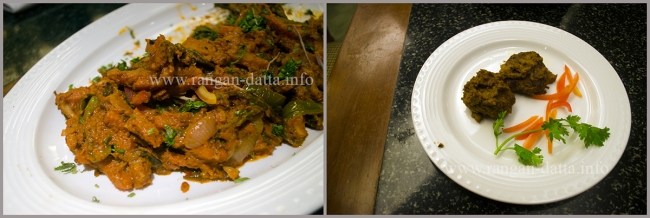Metiabruz Dawat, ITC Sonar, Kolkata
Metiabruz Dawat
ITC Sonar, Kolkata
A saffron flavoured potato, along with chunks of meat, laid in a bed of saffron tinged white and yellow rice is what Kolkatawalas call a biryani. A potato in biryani may sound strange to the rest of Indians but alu has been an integral part of Kolkata Biryani for over 150 years.

Star attraction of the Metiabruz Dawat at ITC Sonar, Kolkata, Mughlai Parantha with Chicken Chap and Mutton Biryani
The story of the alu in biryani goes back to 1856 when the last Nawab of Oudh, Wajid Ali Shah was deported to Kolkata (then Calcutta) by the British and settled in Metibruz area, south of Kolkata.
Some opine that even though the disposed king received a staggering pension of rupees one lakh per month, it was still not enough to feed his large contingent of men, so cooks in his kitchen added the potato to the biryani.
Others, including Shahanshah Mirza, the great great grandson of the last Nawab of Oudh, argues that at that time potato was an exotic vegetable and the addition of potato, in what was basically a rice and meat dish, was a mere experiment, which clicked.
What ever be the reason, the alu in Kolkata Biryani has become an integral part and a die-hard Kolkatawala will always stand by it with his heart and soul, if not his fist.
It was not just the Biryani, but a whole assortment of kebabs, koftas, paranthas and desserts that the Nawab brought to Kolkata.
Soon the khansamas and bawarchis in the royal kitchen started experimenting with the locally available ingredients and, as a result, emerged a cuisine similar in texture but unique in flavour and came to be known as the Metibruz Cuisine.
Under the name Kitchens of India, where the ITC Hotels showcases India’s unique, forgotten and undiscovered cuisines, ITC Sonar hosted the Metibruz Dawat from 16 – 23 April 2016.
“The festival is in keeping with our ethos to celebrate the indigenous offerings of this region, part of our initiative towards Responsible Luxury,” said Atul Bhalla, General Manager, ITC Sonar.
I was invited with a host of food bloggers and other media persons for the media briefing and food tasting session at the Eden Pavilion, ITC Sonar, Kolkata on 12 April 2016. Shahanshah Mirza, the great great grandson of the last Nawab of Oudh, was also present as the chief guest.
It was a hot day and we were refreshed by a tall glass of aam panna. Soon the kababs and tikkas started flowing. The starters included Murg Reshmi Kebab, Machhli Tikka and Paneer Tikka. All were tender and cooked to perfection with the right mix of spices and herbs.
Next came the Veg. Jalfrezi, Yellow Dal and Dum Alu. All this was paired with the Mughlai Parantha.
Strangely the mughlai patantha was not what we Bengalis know, an elaborate parantha stuffed with egg and minced meat.
Sous Chef Gaurav Lavania explained that the mughlai parantha popular among Bengalis is their own creation. The original mughlai parantha is a simple layered parantha fried in ghee.
The simple mughlai parantha was paired perfectly with the Gosht Tikka (Bengali’s call it tikia). Gosh tikka consisted of marinated minced mutton, bounded together with chana dal and finally tawa fried in ghee. It tasted great as the proportion of dal was probably lesser but the tikkas didn’t disintegrate.

Desserts at Metibruz Dawat, ITC Sonar, Kolkata. Clockwise from left: Lachchha, Zarda Pulao and Firni
Finally came the long awaited dish, the Gosht Metibruz Biryani and it was presented by, none other than chef Manzoor Alam, the man behind the Metiabruz Dawat. Manzoor has been born and brought up in Metiabruz and comes from a lineage of babwarchis, so he knows his food well.
The Gosht Metibruz Biryani obviously came in not only with the alu but also an egg. Cooked in dum style, it was a bit greasy but had fine a aroma of ghee and basmati rice and was rightly flavoured with a tinge of saffron and garnished with slices of deep fried onions.
The biryani was paired perfectly with Dai Pudina Ghol (not Burhani) and Bundi Raita.
Last but not the least came the desserts. We were already full but the amazing dessert platter forced us to go far beyond our gastronomic limit.
The desert platter consisted of the Lachchha, Zarda Pulao and Firni. Milk was poured on the thin shreds of lachchha and created an out of the world combination.
The firni and zarda pulao also had a distinctive taste and flavour and it was great way to end the Metibruz Dawat at the ITC Sonar, Kolkata.
But its not just food that links Wajid Ali Shah and Metibruz to the city. The last Nawab of Oudh was a great patron of art & music and created a mini Lucknow in Metibruz.
Sadly his palaces have long been demolished by the Britishers but his Imambara, which houses his mortal remains, and the Shahi Masjid are all that remains of Wajid Ali Shah’s legacy. This can be best explored on a Walking Tour of Metiabruz.




















I’ve been to ITC, Sonar as part of a symposium IIFT conducted there (i did my MBA there in Kolkata with them). Anyway, seems you’ve had a good time…Kolkata has a rich history 🙂
Dear Alok, never knew taht you studied in IIFT, Kolkata. You must have studied in the Saltlake campus. Did Prof. Mukul Mitra teach you??
Yes, i studied from 2007-09 in Salt Lake Campus (now they have their own).
Don’t remember that name, sorry.
Yes now they have shifted to the new campus near Ruby Hospital. Prof. Mitra probably joined after 2009.
Could be, not sure. That’s a great campus they built…i heard.
Royal spread of Biryani and kebab-tikka platter. I am drooling 🙂 It was lovely to read the history behind these dishes…especially how the ‘alu’ landed up in Calcutta Biryani.
Alu in Biryani is always a mystery, still not sure which version is right. This needs a detailed research, hope some one will do it.
Ooooh everything looks so yummy and mouth watering. Perfect food post with accompanied with their history. Thanks for the share Rangan 🙂
Thanks Hema & Suma, it was really yummy. Thanks for the words of appreciation, keep blogging